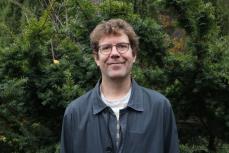Björn Lindahl

Presentation
CV
Publication List
Mycorrhizal Cortinarius species degrade humus
In a field study in boreal pine forest and sub-arctic birch forest, we have found co-localisation of Manganese peroxidase activity and DNA from mycorrhizal Cortinarius species. Mn-peroxidases are enzymes that play a central role in degradation of complex phenolic macromolecules, such as lignin and humus compounds. We also managed to sequence mRNA from soil samples, confirming that Mn-peroxidase genes are expressed by Cortinarius species. Genome sequencing of Cortinarius glaucopus, performed by JGI, found a similar number of peroxidase genes as in many white-rot wood decomposers. Previously, mycorrhizal fungi were largely believe to lack decomposing capacity, as they obtain carbon as sugars directly from their plant hosts. However, these new results support the hypothesis that some groups of ectomycorrhizal fungi may decompose complex organic matter in the soil, perhaps not to obtain carbon, but more likely to forage for organic nitrogen to support their hosts in nutrient poor environments.
Read the whole paper in New Phytologist here.
Mycorrhizal fungi build humus in boreal forests
Combining isotope analysis, fungal biomarkers and high throughput sequencing of fungal DNA, we show that mycorrhizal mycelium is an important source of carbon for long term storage in boreal forest soils. By analysing soil profiles from islands in a lake in northern Sweden, representing a chronosequence of ecosystem age, we found that declining productivity in aging ecosystems is paralleled by increasing accumulation of carbon and nitrogen in fungal mycelium and its remains in the soil.
Read the whole paper in Science here.

Mycorrhizal mycelium. Photo: Adam Bahr
Fungal community analysis by high-throughput sequencing of amplified markers – a user's guide
Taking advantage of the collective experience of six research groups, we here review the different stages involved in fungal community analysis, from field sampling via laboratory procedures to bioinformatics and data interpretation. We discuss potential pitfalls, alternatives, and solutions.
Read the whole paper in New Phytologist here.

Fungi that have previously only been known through DNA sequences, have now been cultivated and classified. The fungi, which have lived hidden underground for millions of years, represent a class of fungi that is new to scientists, Archaeorhizomycetes.
Read the article in Science here.

We approach the diverse ecological roles of fungi as decomposers and ectomycorrhizal symbionts from different viewpoints; from gene expression and biochemistry via community ecology to ecosystem modelling. Molecular methods and bioinformatics are important tools, and we specialise in the use of high throughput sequencing of molecular markers to analyse fungal communities in complex field samples. I am a member of the editorial board of 'Fungal Ecology' and the advisory board for 'New Phytologist'. As director of undergraduate studies, I am also engaged in teaching and organise a yearly recurring master's course in Soil Biology.

Chitinase expression in two interacting wood rotting fungi (Picture: Björn Lindahl).
Ongoing Projects:
- IMPRESS – Integrating microorganism in predictive models of carbon sequestration in soils
- The roles of fungal diversity, forest management and their interactions - analysis and valuation effects on Ecosystem Services – Anders Dahlberg, Björn Lindahl, Roger Finlay, Lucy Rist & Ing-Marie Gren
- Competition between the mycorrhizal and saprotrophic fungal communities of boreal forest soils - Erica Sterkenburg, Karina Clemmensen, Roger Finlay & Björn Lindahl
- Fungal communities in coniferous forest in relation to soil fertility - Erica Sterkenburg, Karina Clemmensen & Björn Lindahl
- The potential of continuous cover forestry to maintain diverse ectomycorrhizal communities - Erica Sterkenburg, Roger Finlay, Björn Lindahl & Anders Dahlberg
- Functioning of litter decomposing fungi in carbon and nitrogen circulation in boreal forests - Johanna Boberg, Jan Stenlid, Roger Finlay & Björn Lindahl
- Fungal peroxidases involved in the degradation of recalcitrant organic matter in boreal forest ecosystems - Inga Bödeker, Karina Clemmensen, Åke Olson & Björn Lindahl
- Tree-fungi-soil interactions in the subarctic-alpine forest-heath ecotone - Karina Clemmensen & Björn Lindahl
- Fungal community composition in alpine forest - effects of tree species, soil warming and elevated CO2 levels - Björn Lindahl & Frank Hagedorn